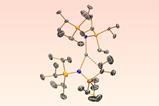A series of compounds featuring fused six-membered silicon rings represents a step up in complexity for the class of structures known as ‘ladder molecules’. The team that created them states that the molecules ‘rank among the most complex organosilanes yet synthesised’ due to their multiple rings and stereogenic centres.
Ladder molecules are so-called because they feature parallel chains of atoms, linked by a series of bonds resembling steps. They generally comprise of two or more consecutively fused rings of atoms. Organic examples include ladderanes, which feature in natural products such as lipids. However, silicon-based equivalents are rarer, with the first examples emerging in the late 1980s. Previous examples included polysilanes made by fusing four-membered silicon rings together.
Now, researchers in the US have synthesised a series of compounds that fuse six- membered silicon rings. These were made by reacting a silicon dianion with a tetrasubstituted cyclohexasilane ring. The team, led by organic chemist Rebekka Klausen from Johns Hopkins University in Baltimore, could obtain products with different stereochemical configurations by varying the reaction time.
Ladder molecules in which the silicon rings were fused in a trans-configuration were shown to absorb light at longer wavelengths than those in which the rings were mainly fused in a cis-configuration. The researchers attribute this effect to enhanced electron delocalisation through the extended silicon network.
By providing insight into how thermodynamics influence the formation of different ladder molecules, Klausen’s team notes that the research will inform future stereoselective syntheses of silicon-based chromophores.
References
R Klausen et al, Angew. Chem. Int. Ed., 2025, DOI: 10.1002/anie.202506054








 User Center
User Center My Training Class
My Training Class Feedback
Feedback
















Comments
Something to say?
Login or Sign up for free